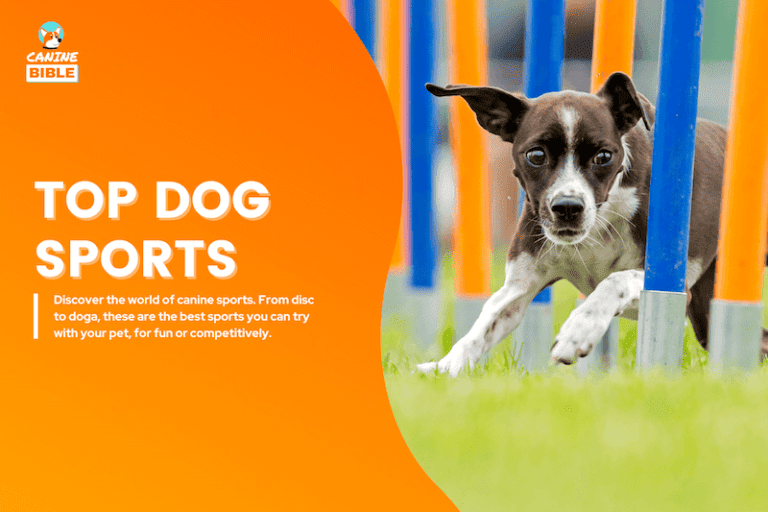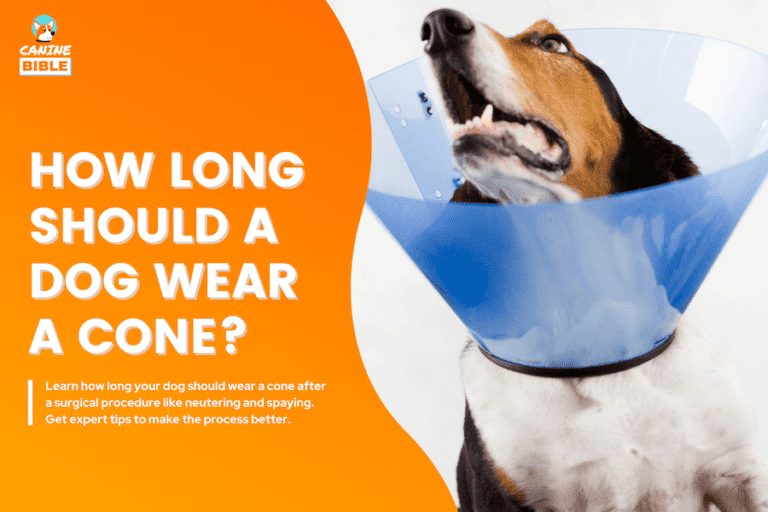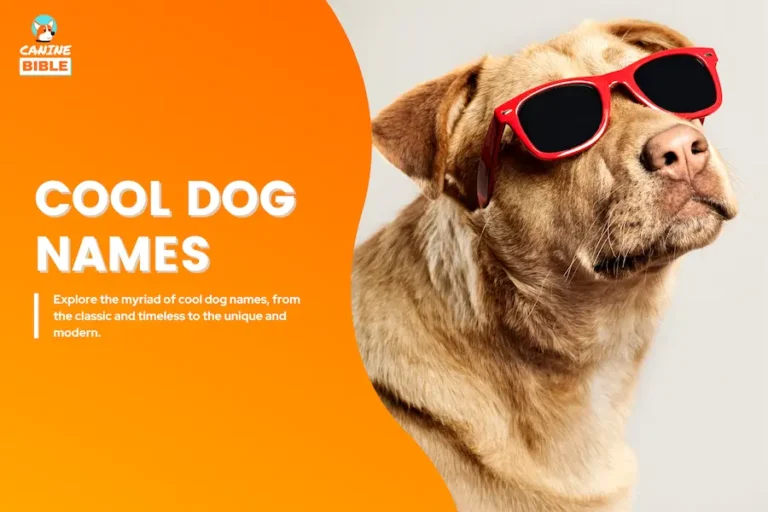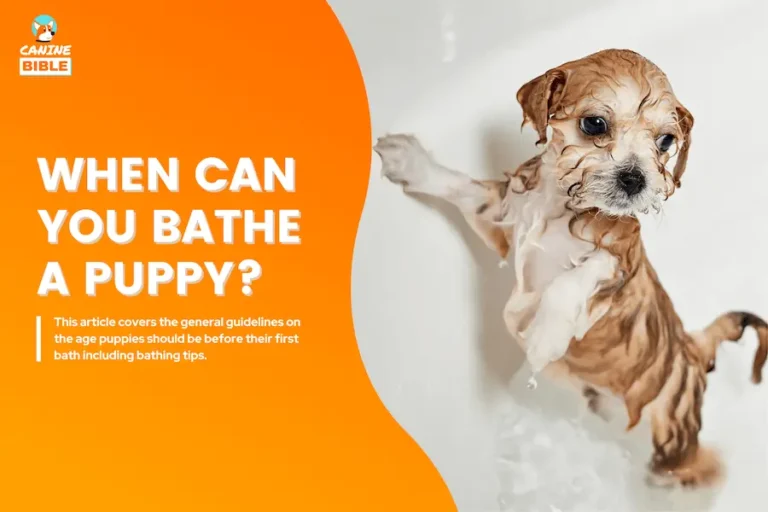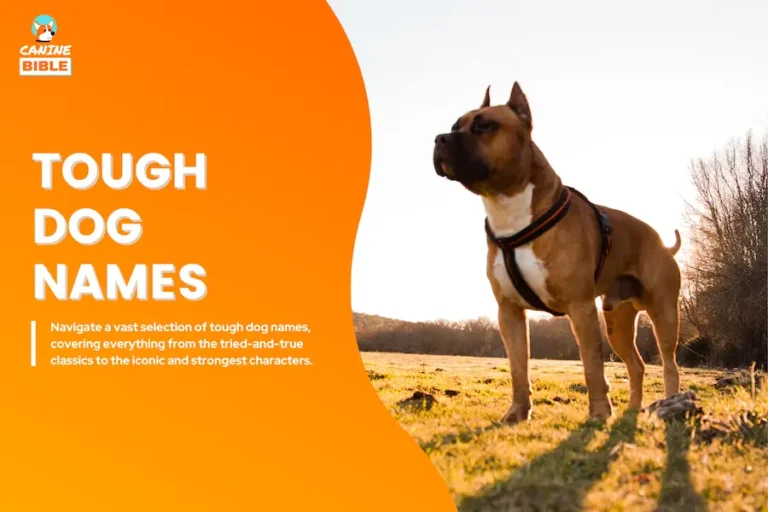Walking A Dog Before or After Eating: How Long Should I Wait, 30 Minutes?
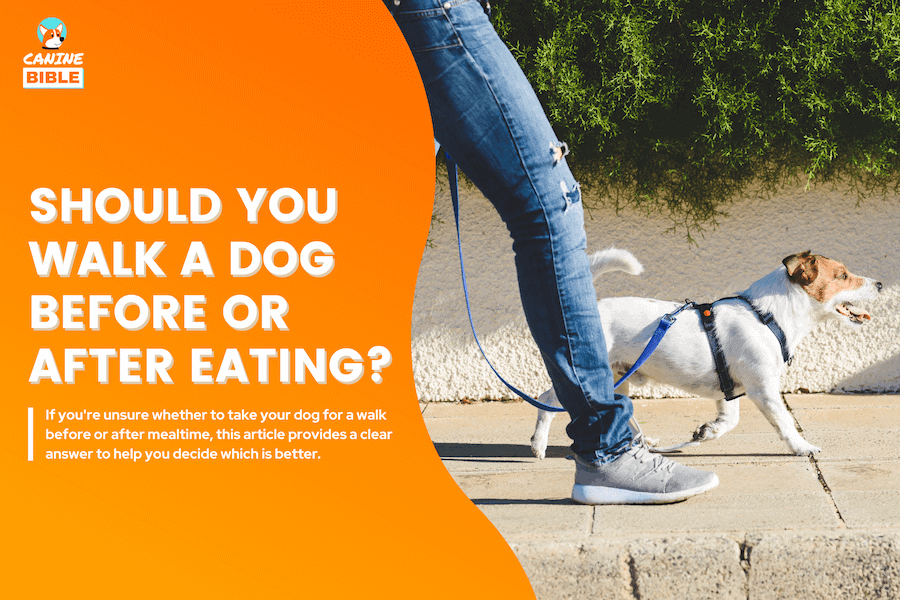
Canine Bible is reader-supported. We receive affiliate commissions via some of our links. This doesn’t affect rankings. Learn more.
Walking and feeding your dog is more than just a routine part of pet care; it’s a crucial decision, as the timing of walks in relation to meals can impact digestion, energy levels, comfort, and more.
Dog owners often face a common dilemma: should I feed my dog before or after a walk? While the answer may seem straightforward, there are important aspects to consider. Some dog parents worry that walking their dogs after eating could lead to bloating (Gastric dilatation-volvulus or stomach twists). However, they’re also concerned that not fueling their dogs before a walk will leave them feeling weak, lethargic, and hungry. So, is feeding a dog before or after a walk better? It depends. In this article, we delve into the nuances of this topic, examining the pros and cons of both options. Let’s dive right in!
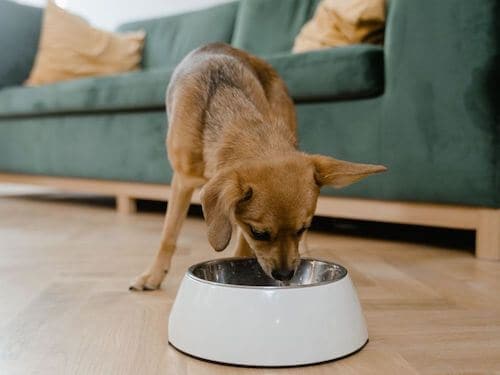
Should I Feed My Dog Before Or After a Walk?
Quick answer: Veterinarians recommend feeding your dog at least 30 minutes after going for a walk. If a dog has been fed before a walk, it’s advised to wait at least 30 minutes following a small snack, up to 1 hour following a small meal and up to 2 hours after a large meal before walking.
Walking A Dog After Eating
Each dog is unique, with varying needs and tolerances, so deciding whether to walk them after feeding depends on several factors, such as the walk’s distance, pace and meal size.
Benefits
A well-timed meal can give your dog the necessary energy for the walk. This is particularly beneficial for longer or more strenuous walks, where they might need that extra fuel to stay active and engaged.
Other benefits include:
Risks
Dogs can quickly experience ‘bloat’ or Gastric Dilation Volvulus (GDV) if they engage in strenuous exercise too soon after eating. Although walking is not a strenuous activity, many dogs get excited during walks and may start running around, which can increase the risk. Walking a dog right after eating could cause the stomach to swell and twist, leading to blockages. This condition can be life-threatening if not treated promptly.
Other risks include
If your dog has tummy or digestive troubles, feeding them a probiotic such as Nom Nom, our best probiotic for dogs, can help. The benefits of dog probiotics can help a dog’s digestive system function more efficiently, particularly after eating.
How Long Should I Wait To Take My Dog Out After Eating?
According to The Vet, a leading veterinary healthcare center, you should not allow your dog to play or exercise (e.g., walk) for at least two hours after a meal to avoid health risks.[1] However, the wait time depends on how much food your dog consumes. A two-hour wait may not be necessary for a small snack or a light meal; one hour should suffice. Conversely, if your dog has consumed a full meal, adhering to the two-hour recommendation is recommended.
On average, food passes through a dog’s stomach slightly slower than humans, but the movement through the intestines is somewhat faster. A dog’s gastrointestinal transit time, or the time it takes to digest a meal fully, is between 6 to 8 hours, according to Dr. David Brummer, a veterinarian at Orchard Park Veterinary Medical Center in Orchard Park, New York.[2]
Therefore, when planning your dog’s exercise routine, it’s important to consider these digestive timings. The downtime before walking your dog should be tailored to the size of the meal and your dog’s individual digestive pace. By aligning walk times with these digestive factors, you can help ensure your dog’s comfort and well-being, minimizing the risk of digestive complications such as bloating or discomfort.
Follow these general rules to be on the safe side:
| Activity | After Small Snack | After Small Meal | After Large Meal |
|---|---|---|---|
| Walking your dog | At least 30 minutes | 1 hour | 2 to 3 hours |
Can I Walk My Dog 30 Minutes After Eating?
Dogs can safely walk 30 minutes after eating a small snack. Walking a dog that has consumed one or two treats should not cause issues such as bloating. If your dog has eaten a large meal, it’s advised to wait at least two hours before walking them. Walking your dog immediately after a meal can lead to problems like bloating, gastric dilatation-volvulus (GDV), or other health issues.
Can I Walk My Dog An Hour After Eating?
Walking a dog one hour after a small meal is perfectly fine. For larger meals, waiting 2 to 3 hours is recommended. If you have allowed your dog sufficient time to digest his food properly, walking him after an hour should be fine.
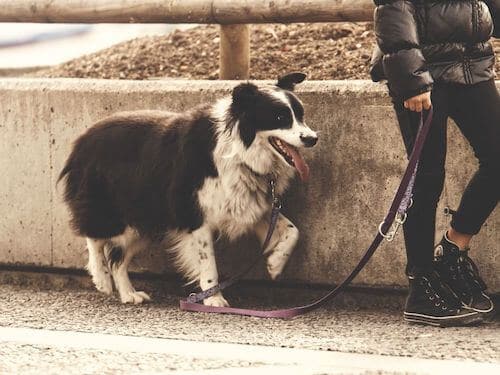
Walking A Dog Before Eating
What is the case for walking a dog before giving him food? The obvious answer is to avoid all the health risks (i.e., stomach twists, bloating, etc.) associated with walking your dog with a full belly. However, there are other substantial reasons to walk a dog before meals. Let’s take a look at the risks first.
Benefits
Walking your dog on an empty stomach may benefit your pup, especially if your dog is overweight. In humans, research supports that exercising in a fasted state can burn more fat than exercising after eating. The same principle may apply to dogs. When a dog is in a fasted state, it triggers the dog’s body to metabolize fat or enter a state of ketosis, which can aid in weight loss for dogs.[3] A study reported that a dog walking at a pace of 3.7 – 4 miles an hour (approximately 15-minute miles) would burn 0.8 calories per pound per mile. This means a 20-pound dog would burn about 64 calories during a one-hour walk.
Walking your dog on an empty stomach, such as first thing in the morning before breakfast, can burn more fat calories — thus increasing their calorie burn rate per mile. When a dog doesn’t eat before a walk (or follows an intermittent eating diet), its body isn’t actively digesting and absorbing large meals. This break from food allows the liver to process waste products more efficiently, reducing the body’s toxic load. This practice not only restricts calorie intake but also offers several benefits.
Giving your dog’s body a break from constantly digesting and processing food not only restricts calories but offers several benefits, including:
A helpful tip when walking Fido on an empty stomach is to carry a couple of treats (our pups love these from Pupford) just in case the walk lasts longer than expected. Treats can be used as motivation or as a reward for your dog’s accomplishment in completing the walk on an empty stomach. It’s also important to carry water during a walk. We recommend using a portable dog water bottle with a filter to remove impurities and residual chlorine.
Risks
According to Dr. Justin Shmalberg, a DVM and Nom Nom’s veterinary nutritionist, dogs are built to endure extended fasting and can go without food or water for 5 to 7 days if they are healthy. So, yes, you can safely walk your dog even if he hasn’t eaten yet, and the risks are minimal. However, it’s essential to note that this doesn’t imply you can starve your dog or engage in long walks or strenuous activities without providing food. It’s crucial to use your good judgment. A short walk may be fine, but if your pup has just woken up after a long night’s sleep, he will probably appreciate breakfast. Long walks or strenuous activities without food are not recommended.
Other risks of not feeding your dog before a walk include the following:
Do not walk your dog before eating if your dog is a puppy, a lactating female, a senior dog, or has a health condition such as diabetes. Talk to your vet first.
How Long Should I Wait to Feed My Dog After A Walk?
Although walks are not as strenuous as exercise and do not require as much time for dogs to cool down, waiting at least 30 minutes before feeding them is still recommended. Some dogs may become overly excited or anxious after returning from a walk with an empty stomach, so waiting until they have entered a calm mental state before offering them food is essential. This can help prevent them from eating too quickly and potentially developing bloat.
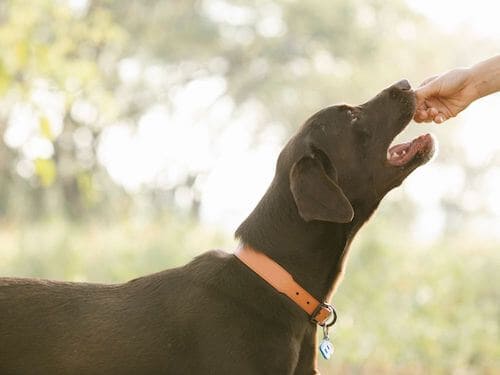
Walk Puppy Before Or After Eating?
Puppies have a different nutrition regimen than adult dogs. Nutrition is critical for proper development. For this reason, feeding puppies before taking them on walks is recommended.
How Long Should You Wait to Walk A Puppy After Eating?
Puppies usually eat three to five times daily from weaning through four to six months. You need to give them plenty of time to digest their food properly. Vets recommend waiting at least one hour before taking your puppy for a walk or playtime.
Should I Feed Or Walk My Dog First In The Morning?
This is a matter of preferences and how your dog’s feeding schedule is set up. Walking your dog first thing in the morning before feeding him is ideal since most dogs need to potty first thing in the morning to prevent accidents. You can choose to do a quick walk after your dog goes potty. A morning walk allows dogs to get their energy out early in the day, often resulting in better behavior and more receptiveness to training. Or, you can opt to return home after the potty and walk him after feeding him. You would need to wait the appropriate time to let the food digest, as we recommend above.
Should I Feed Dog Before or After A Morning Run?
It is generally recommended to feed your dog before running. This gives your dog’s body the fuel to exercise safely and efficiently. Keep your dog’s running light to moderate if you make your dog run on an empty stomach. Check out our Running with Dogs guide to learn more about taking dogs on a run.
How Long Should A Dog Wait to Run After Eating?
As a general guideline, it’s recommended that your dog waits for 2 to 3 hours after a large meal before running. If your dog had a small meal or snack, wait a minimum of 30 minutes or preferably 1 to 2 hours before going for a run. The same rule of thumb applies if your dog practices dog sports.
Frequently Asked Questions
What Is The Best Time to Feed Dog Before Or After Walk?
So, should you walk your dog before or after eating? In depends. Feeding your dog before walking is good for fueling his body with energy for any exercise he will do throughout the day. Another great reason you will want to walk your beloved friend after eating is that it’s easier to establish a feeding and potty schedule. Most dogs urinate or defecate right after having a meal.
On the contrary, if you walk Fido before feeding him (and feed him afterward), you might have to go back out again for a bathroom break. We prefer walking the dogs after they’ve eaten because it’s easier to get into a routine. Whether you feed your dog before or after walks, follow the general rule of thumb of not feeding dogs for at least 30 minutes before or after walking.
You should not walk your dog immediately after a large meal to allow for proper food digestion. Inadequate digestion can cause your dog to experience the health risks mentioned above. There is a reason why both people and dogs feel sluggish after eating. ‘
The body uses energy (glucose) to digest the food you’ve just eaten. Insulin and serotonin are also produced after certain meals, triggering our ‘happy’ and ‘sleep’ hormones.’ Allowing your dog to digest food properly with a post-meal rest period ensures their energy levels are balanced again. We recommend using a pet feeding reminder to manage your feeding routine and to remind you to give your dogs time to digest their food before walking them. If your dog suffers from diabetes, walking or exercising could lead to low blood sugar levels. In such cases, it’s important to consult your veterinarian.
There is no right or wrong approach, but you need to understand the pros and cons before deciding what’s best for your pup so you can do it safely while keeping your dog happy and healthy.
Like It? Subscribe & Share!
Sources
Canine Bible uses only high-quality sources, including peer-reviewed studies, to support the facts within our articles. Read our editorial process and product review methodology to learn more about how we fact-check, test products, and keep our content accurate, reliable, and trustworthy.
- Why exercise before or after a meal can be really bad for your dog. (2017, December 21). The Vet.
- 7 Interesting Facts About Your Dog’s Digestive System. (n.d.). PetMD
- Leung, Y. B., Cave, N. J., Heiser, A., Edwards, P. J. B., Godfrey, A. J. R., & Wester, T. (2020). Metabolic and Immunological Effects of Intermittent Fasting on a Ketogenic Diet Containing Medium-Chain Triglycerides in Healthy Dogs. Frontiers in Veterinary Science, 6.
Canine Bible authorship represents the unified voice of our entire editorial team and our in-house veterinarians rather than a single author. Each article, blog post, and review published under the Canine Bible name undergoes a rigorous review process, involving all team members to guarantee accuracy and up-to-date in accordance with the latest veterinarian research. This collaborative effort is an integral part of our editorial process and aligns with our four pillars of content creation. This approach ensures our content is backed by expert knowledge and factual information, offering our readers reliable, actionable, and trustworthy content.



